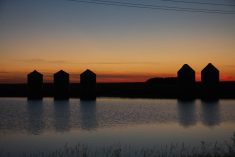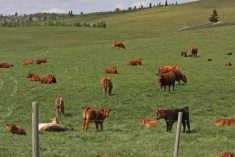ALEXIS CREEK, B.C. – Al and Bev Madley knew their ranch needed an environmental facelift long before going green was fashionable.Their effort to green up their pastures and better manage their water in one of Canada’s driest regions was recognized last year when they won the Canadian Cattlemen’s Association national environmental stewardship award.Canyon Creek Ranch is a fifth generation property in the central interior of British Columbia. The ranch was passed down to Bev, whose great-grandfather, Alex Graham, founded it and nearby Alexis Creek, a village of about 100.Al was a former conservation officer in the region but it was Bev who urged the family to start an environmental farm plan and riparian restoration in 2005.The family had begun repairs 15 years earlier but recent programs provided guidance and funds for fencing and water development.One of the first jobs was moving corrals away from Alexis Creek flowing past their ranch headquarters. Rather than allowing the cows to drink from the creek in winter, geothermal heated waterers were added in the pens. They did not want an electric water system because of frequent winter power failures.“The whole thing in this process is that it has helped us realize what we can do and that there is more to do all the time,” Bev said.“We are learning the health of the land makes a difference.”As a trained conservationist, Al has noticed an attitude shift.“There is a huge concentration on environmental issues compared to when I first was involved,” he said, noting irrigation systems were rudimentary and people used to be less concerned about what ran into the rivers.“People are more environmentally aware now. We have done so much in our education starting right at the kindergarten and Grade 1 level. Everything nowadays is geared at environmental issues,” he said.The environmental farm plan helped fund seven kilometres of permanent fences along riverbanks and around rotational grazing paddocks.The Chilcotin River and its side channels are important to the salmon and trout fisheries so the cattle had to be restricted to designated crossings. The shorelines are now growing in with grass, willow and other vegetation.“The cattle would go in and stand up to their bellies when it was hot and that is not a good thing,” Bev said.They also have a stewardship agreement with Ducks Unlimited to protect waterfowl.Over time, they want to build a future for their son, Garrett, who has his own place on the property and is planning to take over the farm. Garrett helped design fall and winter pastures with smaller paddocks and watering tanks for the cattle. Their daughter Brooke lives in Kamloops.Successful river management requires the involvement of neigh-bours. Bev, president of the Chilcotin Stockmen’s Association, said five of the members have completed environmental farm plans.“The people who live along the river here are all long generation ranches and they have bought into that planning and they look after their river banks,” she said.Grass management is a primary goal because they earn their living from cattle. The regional average rainfall is about 20 centimetres in summer and in recent years, snow cover has been scant with little runoff.They fear their property may suffer because of last year’s drought, dry winter and cold spring.They could irrigate more land but they would have to pay for more water licences every year so that affects their budget.“It makes a huge difference. If we didn’t have water to irrigate, we couldn’t live in this country,” she said.A large part of the ranch depends on crown range where their Hereford based cow herd is grazed during the growing season. Cattle are not allowed on the leases until May 25 and must be off by early October.The lease agreement allows them to do special projects but they also have to share the land with wildlife, ranchers, logging companies, First Nations, hunters and fishers.“We encourage the logging companies to deactivate the roads when they are done so we don’t get all kinds of recreationists ripping around,” she said.
Read Also

Know what costs are involved in keeping crops in the bin
When you’re looking at full bins and rising calf prices, the human reflex is to hold on and hope for more. That’s not a plan. It’s a bet. Storage has a price tag.















